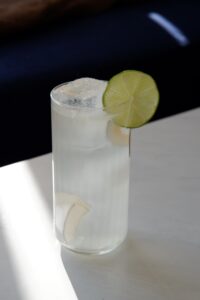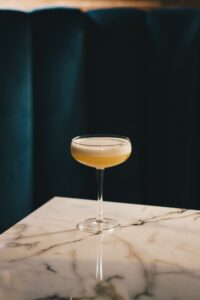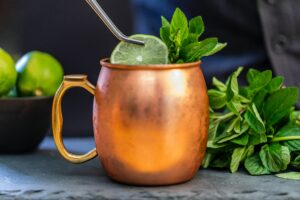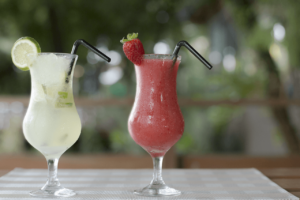Its cocktail hour and you’re looking for the perfect glass to serve your guests. You’ve got a lot of options: martini glasses, wine glasses, highball glasses – what do you choose? In this blog post, we’ll take a look at different types of cocktail glasses and what they’re good for.
Do you need specific glasses for cocktails?
It’s more than just shaking and stirring to make a cocktail; it requires finesse, inventiveness, and, most importantly, the proper drinkware.
Cocktail glasses have been around since long before cocktail stirrers. Historically, they were used for practical purposes, such as improving aromatics and lowering heat transmission. Cocktail glasses of today are as varied as the beverages they contain.
This detailed how-to book helps you narrow down the barware that works best for you by keeping it simple or showcasing your mixology skills with layered cocktails.
Why buy a variety of cocktail glasses?
The goal is to improve the drinking experience, and each type of cocktail glass was created to bring out the subtleties in smell, temperature, color, and taste of the drink inside.
Furthermore, many experts feel that presentation is crucial since the impact of stacked and blended beverages deteriorates when consumed in the wrong glass.
Sometimes, using a certain sort of drinkware is the most logical option. Think libations served in the same vessel as they’re prepared in.
Cocktail glass materials
What materials should you look for when loading up your home bar, and what are some of the most common mistakes people make? It all depends on the beverages you’ll be serving.
The most common material for ice is glass, although metals such as tin and copper are frequently used to insulate chilled drinks. Mint Juleps and Moscow Mules, among other beverages, have been prepared with it.
Acrylic drinkware is a popular choice among bartenders because it’s affordable and long-lasting. Mixologists especially like it since beverages are served in a casual or outdoor setting.
Cocktail glass styles
Today’s cocktail glasses, in addition to drinking, enhance the ambiance and encourage conversation. Finding a cocktail glass design that complements your event is simple.
For example, classic stemware is ideal for formal events while barware in vivid colors and exciting designs is perfect for a low-key happy hour. In any case, having a selection of cocktail glasses on hand allows you to show off when hosting pals and family.
Cocktail Glasses
Cocktail glasses are barware used to serving mixed drinks. Cocktail glasses come in a variety of shapes and sizes, making this bar equipment as adaptable as it is useful.
Highball Glass
Highball glasses, on the other hand, are big and tall with a slender neck. They’re suitable for all sorts of beverages, including high cocktails like Seven and Seven and Scotch and soda, as well as rum and Coke.
Bartenders frequently mix drinks in highball glasses right inside the glass, with the shaken ingredients being poured over ice afterward.
This form of glassware, which has a capacity of between 8 and 12 ounces, is taller than traditional glass and shorter than a Collins glass.
Lowball Glass
Lowball glasses are a shortened form of highball glass that is frequently used for serving spirits such as whiskey.
With a sturdy and broad foundation, lowball glasses are fantastic for muddling non-liquid components like mint and other herbs with the drink’s main liquid components.
Bully sticks are available in two sizes: single (6-10 oz.) and double (12-16 oz.).
Nick and Nora glasses
Nick and Nora goblets are becoming increasingly popular in craft-cocktail bars, just like coupes. Many professional bartenders prefer Nick and Nora glasses for stirred-up drinks and coupe glasses for shaken-up drinks because the smaller Nick and Nora glasses can contain three to four ounces of liquid without spilling.
However, if you want to keep your glassware to a minimum, there’s nothing that can’t be served in a delightful coupe. Nick and Noras glasses are usually more specialized and difficult to come by.
Collins Glass
The Collins glass, frequently known as a cooler glass, is similar to the highball glass in that it is taller and narrower.
Collins glasses are most often used to serving mixed drinks, particularly Tom Collins and John Collins cocktails. When serving high cocktails that would otherwise be served in a highball glass, they’re an excellent alternative.
Collins glasses are cylindrical and hold 10-14 oz.
Martini Glass
Martini glasses have been a classic since the 1925 Paris Exhibition when they were first used for champagne consumption. They were originally designed for champagne drinking rather than cocktails.
Today’s model has longer stems to reduce heat transfer and a broader brim for a better liquor aroma. Steeply sloping sides also assist support toothpicks and skewers while preventing ingredients from separating.
Martini glasses are typically available in two sizes: regular (3-10 oz.) and enormous (6-12 oz.).
Rocks Glass
Rock glasses are short, broad, and robust, and they’re used to serving spirits over ice as well as distilled beverages and sweet drinks that need to be consumed in large amounts. The cocktails produced in rocks glasses are frequently prepared right inside the glass, making it simple to layer the distinct tastes with ice and alcohol.
Rock glasses come in two sizes: single (6-8 oz.) and double (10-14 oz.).
Specialty drink enthusiasts warn that finishing each beverage with a gentle stir is the greatest method to enjoy drinks served in a rocks glass.
Specialty Cocktail Glasses
The same as the preceding types of glasses, these uncommon glasses add a unique spin to time-honored classics as well as your own handmade goods.
Margarita Glass
The margarita glass, usually made with a combination of fruits, comes in a variety of shapes and forms.
The most popular welled bowl, which is generally garnished with salt, has a narrow near the stem and wide at the rim. Another advantage: margarita glasses are also used to serving finger foods and hors d’oeuvres. Consider shrimp cocktails, fruit combinations, and several chips and vegetable dips.
A word of caution: the form of glass margaritas varies depending on the occasion. For example, for a more formal dinner, glasses with margaritas in them would be used, whereas informal parties would use old-fashioned glasses instead.
Copper Mug
Copper mugs are known for their ability to instantly turn (and remain) chilly, insulating the drink being served.
Copper mugs feature a handle that minimizes heat transmission, whether you’re drinking an adult beverage or something non-alcoholic, like iced tea, water, and other chilled beverages.
A quick tip: some people believe that the copper mug’s metal construction improves the taste of the beverage served.
Chimney or Zombie Glass
Chimney (or zombie) glasses, like Collins glasses, are tall, narrow, straight-sided, cylindrical glassware ideal for serving lengthy mixed beverages.
Punch Cup
Punch cups are smaller than other cocktail glasses and are used to serving smaller portions of stronger beverages.
Drinks from punch glasses are popular with big batches of egg nog and other fruity punches, in which they are first combined in a basin, then poured into the individual cups.
Punch glassware is any glass, ceramic, or silver vessel in which a punch may be served.
Julep Cup
Julep cups, like copper mugs, are often used to quickly insulate cold drinks such as Mint Juleps.
Julep cups, which were originally designed for the Kentucky Derby and are now enjoyed as collectors’ items, are typically made of silver or pewter.
Tip for the pot: beverages prepared in Julep cups are best served with crushed or shaved ice, rather than cubes.
Shot Glass
Shot glasses are tiny, short, and narrow. They’re used for rapid sipping of straight alcohol. The majority of shots are consumed straight from the glass, but a few are dropped into a drink.
For more creative cocktails, a taller shot glass is used to showcase artistic beverages with layers of color, flavor, and other ingredients.
Most classic wine glasses have a volume of 1.5 ounces and 2-3 ounces, although there are also small (1.5 oz.) and big (2-3 oz.) single and double shot glasses available.
Fishbowl
Sometimes, bigger is better! Fishbowl glasses, which are true to their name and size, are a popular choice for serving cocktails on a larger scale. With ice and fruit garnishes in these big, spherical, stemmed glasses, mixed drinks with several liquors, juices, and other components have plenty of space to settle.
Hurricane Glass
The useful versatility of hurricane glasses is shown in this example when the pleasant curvature of each glass enhances the overall presentation. This glass, which typically measures 20 ounces, was given its name owing to the Hurricane cocktail, which originated in New Orleans. Anyone for rum, juice, and grenadine?
The perfect cocktail glass for each drink
There are many types of cocktail glasses, and each one is suited for a different purpose. Some glasses are better for serving margaritas, while others are perfect for serving punches. Some glasses are great for keeping drinks cold, while others are perfect for displaying cocktails that have layers of color and flavor. No matter what your needs are, there is sure to be a cocktail glass that is perfect for you.
Disclaimer
We hope you enjoyed reading our article, however we do suggest you read our disclaimer. All the material written in this report is provided for informational purposes only and is general in nature.
Every person is a unique individual and what has worked for some or even many may not work for you. Any information perceived as advice by must be considered in light of your own particular set of circumstances.
Please drink responsibly!
The author or person sharing this information does not assume any responsibility for the accuracy or outcome of your use of the content.

